Christmas Island: The World's Testing Lab
Part One of a Two-Part Series Focusing on
Christmas Island
'Twas an early morning on Christmas Island, when out on the beach, this reporter was on assignment, his drink within reach..
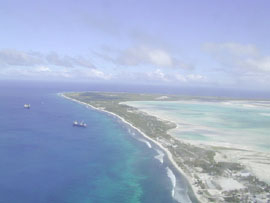
The wind was blowing hard, as it had for the entire week. Red land crabs scurried in and out of their small burrows nestled between broken bits of coral at the shore's edge. Rolling in from the reef to within a few feet of these sand houses was the sometimes turbulent and always thunderous surf.
I closed my eyes for some timely contemplation and the untangling of a few thoughts when a cool shadow fell over me. I turned back over and peered skyward to find a man's silhouette.
"The name's Nicholas," he said. The wind tossed his beard and loose-fitting clothing. Above him sooty terns swirled in the pattern that usually signals imminent rain.
I stood up slowly with equal parts hesitation and hangover and brushed off a little sand. "You live around here?" I asked, now seeing that he was a middle-aged foreigner, stout and round, white beard, and red and weathered face.
"Yep. Got my own factory out on the end of the island," he said. Used to live up north a ways, but the winters were murder and the labor here is cheap."
I reached inside the pocket of my Reyn Spooner for my lighter and hung a smoke from between my lips.
"Come on, let's go," he urged.
"Where?" I asked, getting in a few puffs before he had pulled me back to the hotel's gravel parking lot.
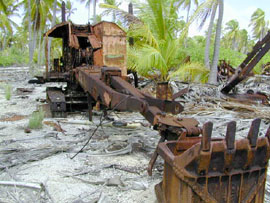 "Well," he said opening the passenger door, "I think it's time you saw more of Christmas Island than the bottom of an ashtray and the inside of an empty lobster shell. You'd be surprised at how much the foreign scientific community likes using this coral atoll as a guinea pig."
"Well," he said opening the passenger door, "I think it's time you saw more of Christmas Island than the bottom of an ashtray and the inside of an empty lobster shell. You'd be surprised at how much the foreign scientific community likes using this coral atoll as a guinea pig."
Away on the horizon there came a great flash, tore open the sky and threw up a large splash...
That rain did start once we were on the island's one main road. Large drops splattered the windshield of our black 4x4. Dozens more land crabs chanced death by crossing in front of us, usually raising a single white claw in protest, or perhaps defense. Pigs and chickens, though the locals are sustained primarily on fish, scurried amongst the small thatched huts and smoldering husk fires of the camps along the road as we approached one of the island's three major villages - Banana. Just beyond is Cassidy Field, the island's one-flight-a-week commercial airport, and there we headed towards the lagoon on a bumpy dirt road lined by palms and strewn with coconut shells. Though the road quickly became strewn with something else altogether.
At a junction, we paused at the site of rusted and deteriorating corpses of jeeps, tractors, bulldozers, trucks, cranes, water haulers, and other unidentifiable vehicles scattered between bushes and beneath a canopy of fronds not far from the lagoon. With the sun now peaking between the clouds, I opened my door and stepped between bits of rusted engines, dislodged steering wheels, pieces of gearboxes, broken axles, and rotting tires.
"So what is all this from?" I asked.
"Junked scientific testing equipment from a past time. There's more," he said just before moved back from under the swaying palms and into the car to begin our way back to the main road.
Today the independent nation of Kiribati claims Christmas Island, about a thousand miles south of Honolulu, as its own. But back in the 1950s and '60s, this island, shaped approximately like a cross-section of a Venus Fly Trap with the locale of the doomed insect being a large lagoon surrounded by pair of low lying converging landmasses, was a part of the British colony of the Gilbert and Ellice Islands. During this time, the British and U.S. performed a series of nuclear tests, codenamed Grapple and Dominic respectively, at various locations on the island. Though not as infamous for their devastation as those laid on the Marshall Islands by the U.S., the tests at Christmas Island were by no means routine.
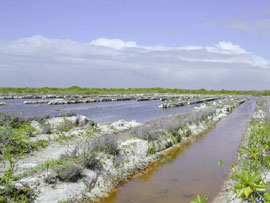 "Some of the workers during the tests said that they could see the bones in their hands," Nicholas started from our new location near the southeast tip of the island, "even with their eyes closed and with protective glasses."
"Some of the workers during the tests said that they could see the bones in their hands," Nicholas started from our new location near the southeast tip of the island, "even with their eyes closed and with protective glasses."
I looked at my palms and then to the sky.
"In 1999," he continued, "some Fijian soldiers, used in the testing and at the time under British military command, filed compensation lawsuits against the British Government for health problems, such as leukemia and anemia, that resulted from the subsequent fallout. So far, the British haven't paid out a dime. Further, biologists estimated that over one million birds were blinded during the tests. Of course, they died soon after as they couldn't find food."
While we stood over one of the old testing sites, sooty terns darted overhead beneath a darkening sky in flocks of thousands, their squawks loud enough to break up the roar of the nearby surf.
The site is a square slab of concrete surrounded by a circular-shaped area of gravel with shrubs encroaching from all directions. Two semi-circular rings of iron protrude from the center of the slab. Since most of the U.S. tests were detonated off the coast with explosives released from B-52 bombers, this marked site is probably a target used for some of the fission tests the British delivered from balloons. Further up the road, beyond a series of rust bottomed vernal pools, Nicholas stopped the car at another monument to the island's nuclear past.
A rusted shelter built into the side of a small sand dune, its doors broken at the hinges and its iron support ties fallen by the wayside, lies at the road's edge near an open grass field. From inside this bank vault-like alcove, exposed wiring and dollops of asbestos dangled from the ceiling and doorway, Nicholas further explained, "In addition to the testing that used this shelter, the Sea Launch project, a joint Boeing-Russian-Norwegian company, has as recently as a few months ago fired satellites into space from a floating platform just to the south of the island. Just one week ago, their latest mission was aborted sixteen seconds before launch." We read some of the graffiti, as we were far from the first to find this nuclear house, and stepped outside to greet more flying birds.
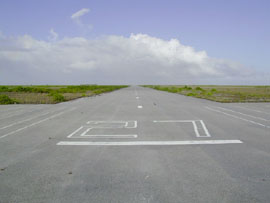 "So what are they launching the satellites for?" I asked.
"So what are they launching the satellites for?" I asked.
"For radio stations. Apparently this latest project required the launch of two satellites; one Rock, the other Roll. They'll be back to try again though. Someone always comes back."
Indeed, but sometimes they fall from space.
When, what to my wondering eyes should appear, but a miniature space ship, and three tiny landing gear...
We started towards the shore on a small, unpaved road. Nicholas turned and asked, "On the way here from the junkyard we passed another air strip - Aeon Field. Do you remember?"
Even with visions of the unending and untouched coastline lined by shoals of broken coral and crustacean shells, acres of palm plantations, and a single paved roadway hemmed in by chest high shrubs filing through my still slightly cluttered head, I was indeed able to recall such a field. While pulling my pack from my pocket, I nodded to acknowledge such.
"Well the Japanese government's National Space Development Agency, NASDA, is going to use that to land their space shuttle. The British built it back during the testing but never used it. It's a nice, large, and almost new strip."
We arrived at a beach, purportedly the furthest southeast point of the island and in the vicinity of a wrecked Korean ship from some 20 years prior. Clouds moved swiftly overhead, but without rain.
"Eventually they'll launch the ship from here too," he pointed out over the horizon. "The project is codenamed HOPE-X. It's an unmanned craft that is supposed to develop technologies in reusable space transport. They'll be conducting a high-speed flight experiment later this year."
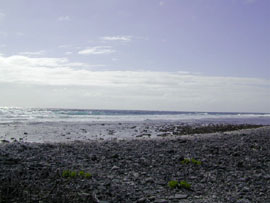 I wound up and tossed a small piece of coral into the surf, adjusting my pitch for the strong the breeze crossing the beach.
I wound up and tossed a small piece of coral into the surf, adjusting my pitch for the strong the breeze crossing the beach.
"Did you know that this point was the first to see the millennium light about a year ago?" he asked, stroking his beard.
"No, had no idea." I gripped my lighter.
"Well, maybe this millennium, Christmas Island will be known more for fishing than fission," he said turning back toward the car.
I lit a cigarette and let a few rings float skyward out over the sea.
Coming
next week: a look at Christmas Island's bread and butter
-- fishing.

